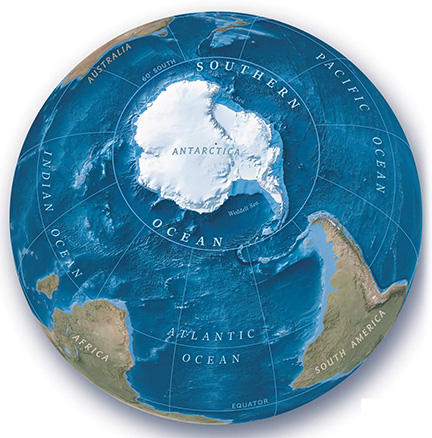Important Facts For Prelims
Southern Ocean
- 15 Jun 2021
- 3 min read
Why in News
Recently, on the occasion of World Ocean Day (8th June), the National Geographic magazine has recognised the ‘Southern Ocean’ as the world’s fifth ocean.
- The International Hydrographic Organization too had recognised ‘Southern Ocean’ as a distinct body of water surrounding Antarctica in 1937 but had repealed the same in 1953.
- Other four Oceans are: Atlantic, Pacific, Indian, and Arctic Oceans.
International Hydrographic Organization
- IHO is an intergovernmental consultative and technical organization that was established in 1921 to support the safety of navigation and the protection of the marine environment.
- India is also a member of IHO.
Key Points
- About:
- Most of the waters that surround Antarctica out to 60 degrees south latitude, excluding the Drake Passage and Scotia Sea, constitute the newly acknowledged Southern Ocean.
- The Southern Ocean is the only ocean ‘to touch three other oceans (Pacific, Atlantic and Indian Ocean) and to completely embrace a continent rather than being embraced by them’.
- It is also defined by its Antarctic Circumpolar Current that was formed 34 million years ago. The current flows from west to east around Antarctica.
- Antarctic Circumpolar Current:
- ACC is the only current in the global ocean to close upon itself in a circumpolar loop.
- This trait makes the ACC the most important current in the Earth’s climate system because it links the Atlantic, Pacific and Indian Oceans and is the primary means of inter-basin exchange of heat, carbon dioxide, chemicals, biology and other tracers.
- The ACC is created by the combined effects of strong westerly winds across the Southern Ocean, and the big change in surface temperatures between the Equator and the poles.
- Ocean density increases as water gets colder and as it gets more salty. The warm, salty surface waters of the subtropics are much lighter than the cold, fresher waters close to Antarctica.
- The depth of constant density levels slopes up towards Antarctica. The westerly winds make this slope steeper, and the ACC rides eastward along it, faster where the slope is steeper, and weaker where it’s flatter.
- ACC is the only current in the global ocean to close upon itself in a circumpolar loop.
- Significance of Recognition:
- Step towards conservation of World’s Oceans, focusing public awareness onto a region in particular needing a conservation spotlight.
- In addition to the rapid warming of the Southern Ocean due to global warming, industrial fishing on species like krill and Patagonian toothfish had been a concern for decades. It hoped to draw attention to these issues.





